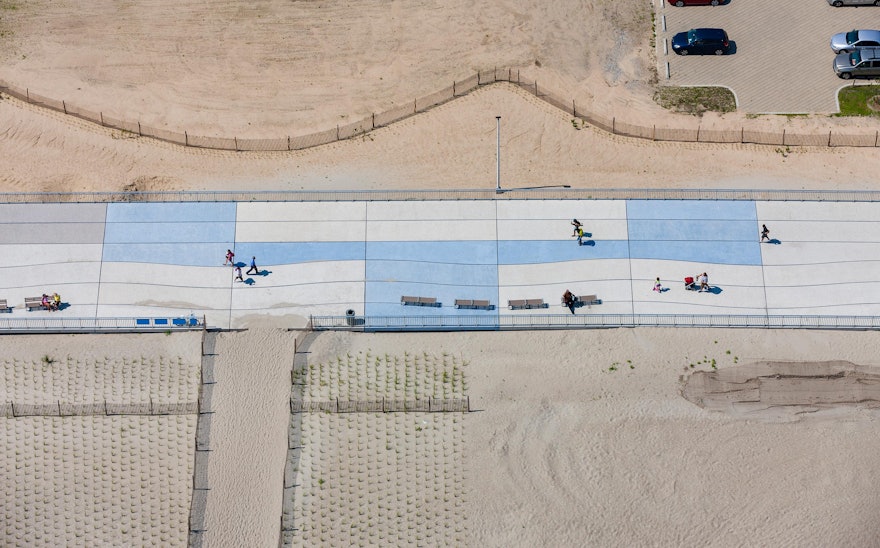When Hurricane Sandy devastated New York in 2012, Rockaway Beach in Queens lost much of its iconic boardwalk. This summer, as part of the ongoing restoration of the area, the first sections of a new boardwalk have been completed and reopened to the public with a more resilient design that replaces the traditional wooden planks with steel-reinforced concrete. Pentagram has created graphics for the new boardwalk that helps put Rockaway back on the map, literally: The typography announces the beach in letters that are each 100 to 150 feet wide and almost 50 feet tall, and together span nearly a mile.
Pentagram collaborated on the new project with the boardwalk architects, WXY, and engineers, CH2M, who are working with the New York City Department of Parks and Recreation, the New York City Department of Design and Construction, and the U.S. Army Corps of Engineers. The graphics build on Pentagram's previous work for NYC Beaches, which included a new signage system for beach access and brightly colored supergraphics for Rockaway's new amenity buildings.
The massive scale of the boardwalk typography was inspired by the immense size of Rockaway Beach, which stretches for 5.5 miles, and its proximity to John F. Kennedy International Airport. The word "Rockaway" can be seen by jets flying overhead—making it by far the biggest type Pentagram has ever designed.
The new boardwalk is constructed of thick concrete pads reinforced with sunken steel pilings and is built above the 100-year flood level. Directly integrated into the boardwalk, the “Rockaway” letterforms are built out of the wave-like patterns that WXY designed for the concrete. Each panel is used as a pixel in the typeface, which is not based on an existing font. (The designers developed a full alphabet for possible future use in other applications.) The blue color is inspired by the sea and the sky, and ties into the brightly colored palette of the environmental graphics Pentagram previously developed for NYC Beaches. To create the distinctive blue, dyed precast concrete was mixed with a blue aggregate, so the color, like the boardwalk, will last for years to come.
The replacement of portions of the wooden boardwalk with concrete actually started a few years before Sandy, but the storm hastened the process when the structure needed to be rebuilt. The first reopened segment of the new boardwalk runs one continuous mile from Beach 86th to Beach 107th Streets, and will be followed by the opening of 4.7 miles in 2016 that will link together intact portions of the old boardwalk and new sections. Some of the recycled planks from the original boardwalk are also being used for new benches and steps. The boardwalk will be entirely completed with new construction by Memorial Day 2017.

